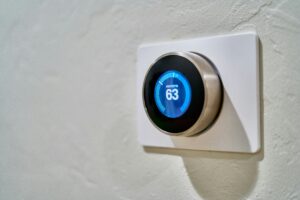You may have heard the phrase “smart home.” You may even have a general idea of what it means regarding eco-friendly technology and overall energy efficiency. But have you ever really explored smart home projects and what they might mean for you?
If not, don’t worry! That’s what the Prairie Electric blog is for.
We connect you with information — as well as more than 200 of the best electricians in Vancouver, Washington. We have loads of experience with commercial, residential, and transportation/utility electrical projects. Contact us today with any questions.
Smart Home Tech
Smart home technology has a large role to play in the implementation of current electrical systems as well as those being designed for future applications. Let’s look at how things are shaping up in the world of smart home projects, specifically.
The U.S. Department of Energy’s Office of Energy Efficiency and Renewable Energy (EERE) is an excellent resource for info on smart home technologies. They say that “from advanced heating and cooling to energy-efficient appliances, these technologies can keep costs low and, in some instances, even improve the value of your home.”
The EERE lists four clean-energy upgrades that can help homeowners:
Solar panels connected to the smart grid.
Solar panel tech has improved markedly over the last few decades, but what is the smart grid? As the folks at SmartGrid.gov tell us, it’s “digital technology that allows for two-way communication between the utility and its customers” plus “sensing along the transmission lines.”
Think of it as an interconnected electrical service network that allows for real-time control and automation between emerging technologies and the equipment that delivers electricity.
“These technologies will work with the electrical grid to respond digitally to our quickly changing electric demand,” SmartGrid.gov says.
Connected Thermostats.
According to the EERE, “The average American household spends around half its annual energy bill on heating and cooling. Connected thermostats automatically adjust temperature points — even when nobody is home — and hold the potential for enormous energy and cost savings.”
Furthermore, some smart thermostats respond to voice commands or (for an old-school feel) remote control.
Smart Windows.
Windows? Yes, windows!
Energy-efficient windows are a crucial part of every smart home project. What’s the point of having solar power or connected thermostats if conditioned air is escaping from poorly designed windows?
The EERC reports that 95% of builders nationwide include energy-efficient windows on home builds. Even older windows can be made more efficient with a few DIY smart home projects, such as caulking and window coverings. Shades and blinds can even be automated.
LED Lighting.
This is another essential piece of a smart home. While not technically smart lights, per se, it is wise to utilize them.
“LEDs use at least 75% less energy,” writes the EERC, “and last 25 times longer than traditional incandescent lighting. They’re also more durable. LED bulbs installed in your infant’s room could still be in place when they graduate from high school.”
Now that’s smart.
What’s New In Smart Home Technology?
So far, we’ve just gone over a few smart home technologies that have actually been around for quite some time. But what’s new and cutting edge?
Modern smart homes often contain more than smart locks and gadgets that respond to voice controls. There are also nifty bits of technology that monitor and improve air quality. Other examples of smart home tech include the continuing development of security systems. (For example, a garage door opens when the security camera recognizes your vehicle — its license plate, really — pulling into the driveway.)
Smart home devices include light switches that automatically adjust ambient lighting and energy storage systems that power your home using renewable energy sources. The Alliance to Save Energy reports on “water heater and HVAC systems (that) interact with the grid to manage and shift energy consumption, while maintaining customer comfort, through thermal-energy storage.”
Of course, no smart home is complete without smart appliances, which can be controlled with apps, and smart showers that help conserve both energy and water. Smart monitoring systems can keep track of all of this, plus schedule lawn watering, coffee making, and more.
What is on your smart home dream list? Any DIY projects underway? What about apps that improve the functionality and/or usefulness of digital assistants, such as the Amazon Echo or Google Home.
Get in touch with Prairie Electric today, and let’s start a smart conversation!


